Home
A comprehensive resource for safe and responsible laser use
Hong Kong, China: UPDATED - Widespread use of laser pointers during protests
Protests against increased Chinese control of Hong Kong began in March and April 2019. On June 21, lasers were aimed at police officers' eyes.
The use of lasers increased dramatically after the August 6 2019, arrest of 20-year-old Hong Kong Baptist University student union president Keith Fong for having 10 laser pointers. (According to the South China Morning Post, laser pointers are readily available for less than HK $100 [USD $13].) Fong claimed he purchased them for stargazing. Persons around him chanted "release him" but police arrested him for "possession of offensive weapons.”
Police said that laser pointers are not prohibited in Hong Kong, but if they are used in an attack or are intended for use in an attack, then they are considered offensive weapons. During an August 7 2019 press conference, Li Kwai-wah, Superintendent of the Organized Crime and Triad Bureau said “…many of our colleagues have been injured by these items. And sensors in some of our video cameras were damaged. So we strongly believe that these items, which are capable of hurting people and destroying things, are indeed ‘offensive weapons.’” Police then demonstrated how the blue beam from a pointer taken from Fong could cause black ink on a newspaper to begin smoking at a range of about 20 inches.
Fong’s arrest set off demonstrations and a rally to demand his release. Critics of the police arrest said Fong’s laser pointers were legal unless they were actually being used to attack. The protests were marked by widespread use of laser pointers. At one point, a protester held up a newspaper and dozens of lasers were shined on it, without affecting the paper. (This was to show how laser beams as used in demonstrations — at distances much longer than 20 inches and handheld onto uncooperative targets — would not have the same effect as holding a beam steady on an unmoving target at close range.)
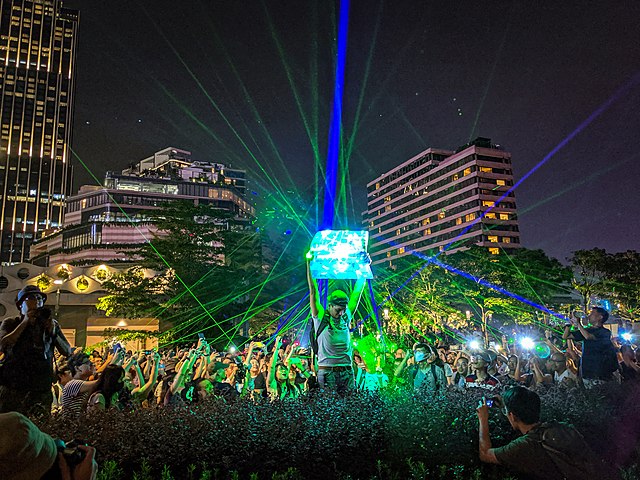
Studio Incendo via Wikipedia, cc-by-2.0
Protesters also aimed their laser pointers at the dome of the Hong Kong Space Museum, creating a "laser show" that may have been a takeoff on the nightly "Symphony of Lights" show around Hong Kong's harbor.
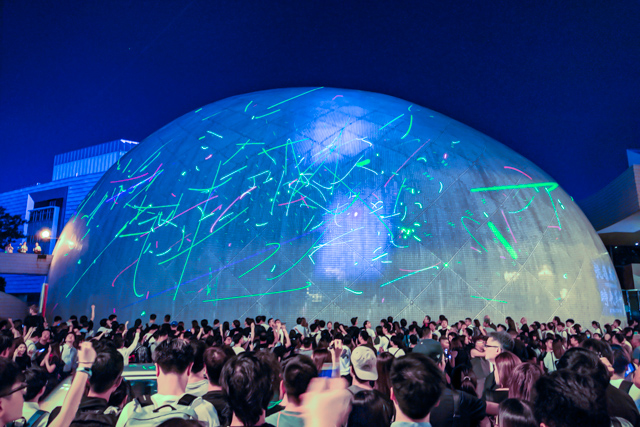
Protesters at the Hong Kong Science Museum. Studio Incendo via Wikipedia, cc-by-2.0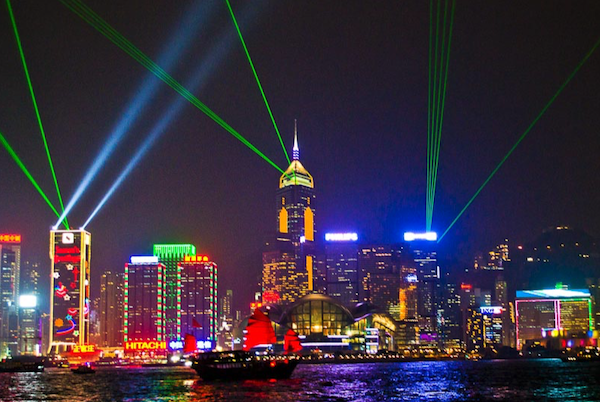
Hong Kong Symphony of Lights laser show, presented nightly at 8 pm by the Hong Kong Tourism Board.
According to Wikipedia, during the laser pointer protest "some chanted slogans like 'laser pointer revolution' and joked 'Is the building on fire yet?' They hoped to show support to Fong and voice condemnation of his arrest by police, and to show that laser pointers are neither offensive weapons nor effective enough to cause a fire." A writer tweeted that the mood was festive: "This is the joyous, comedic side of [the protests] I’ve been missing amid the miasma of tear gas. Tonight was something we all needed: no tears, no blood, just laughter, song, and dance.”
Fong was released on August 8 2019, after being detained for two days.
Use of laser pointers continued in subsequent protests. For example, on August 10 a female flight attendant, Kwok Lai-fan, 28, was arrested for assaulting a police officer using a laser pointer.
On August 13, during demonstrations that closed Hong Kong airport, a person was beaten by protesters. According to Global Times, "the rioters began assaulting him by cuffing his hands behind his back, splashing water on his head and pointing laser beams into his face. He was denied medical help for hours until being rescued at around 10:40pm by Hong Kong police."
On August 14, lasers were aimed at a police station in the Sham Shui Po area of Kowloon. Police responded by firing tear gas to disperse the group.
On November 7, a 16-year-old boy was the first person convicted of possessing a laser pointer at the protests. During the trial, an expert testified that a laser pointer could injure eyes depending on the distance to the victim and the length of time the laser was in the victim's eyes. The judge said the boy's use of the pointer "was meant to harm the eyes of police officers, causing them discomfort." He ruled the pointer was not inherently an offensive weapon, but could become one depending on the circumstances and intent. On or around November 26, the unnamed teen was sentenced to attend a rehabilitation center where he will serve a short custodial sentence and receive work training and counseling.
For more photos and information, see the page "Laser use during protests"
From Vice News (Aug. 8 2019 story about "All-Night Laser Party"), South China Morning Post (Aug. 7 story, "Hongkongers rally to demand release of student arrested over possession of laser pens"; Aug. 8 story, "Laser pointer as 'weapon', explained"; Aug. 12 story, Flight attendant, audio technician and security guard among those arrested during another weekend of Hong Kong protests; Nov. 7 story "Boy, 16, is first to be convicted of possessing laser pointer at Hong Kong protests"), CBC News (Aug. 11 story, "Hong Kong protesters use laser pointers to deter police, scramble facial recognition"), Infosurhoy (Aug. 13 story, "Hong Kong protesters gather for 'laser show' rally"), Washington Post (Aug. 14 story, "After airport mayhem, Hong Kong protesters face tipping point in battle for hearts and minds"), Global Times (Aug. 14 story, "Netizens furious over rioters' assault of mainland passenger at HK airport"), Wikipedia article on "2019 Hong Kong anti-extradition bill protests" accessed August 14 2019, Hong Kong Free Press (Nov. 26 story, "Hong Kong court sends 16-year-old to rehab for carrying laser pointer, hiking pole and modified umbrella at demo")
UPDATES
On May 20 2020, the 16-year-old boy mentioned above (Nov. 7 2019) lost his appeal. The judge concluded the lower court was correct to characterize his carrying a laser pointer as an "offensive weapon" under Hong Kong law.
On July 23 2020, a man was sentenced to 100 hours of community service for aiming laser beams at a police station near his house. The beams were not related to the protests; we are reporting it here since he was originally charged with violating a Hong Kong law stating that lasers are offensive weapons.
On July 24 2020, a man was acquitted of a charge of possessing offensive weapons including a baton and a laser pointer.
China: Laser pointers "regularly" harm children's eyes
It notes that an 8-year-old boy playing with a laser pointer suffered irreversible retinal damage to his left eye.
The story says "such cases are not rare" at the Shanghai Xinshijie Eye Hospital.
It also says that a "study conducted by the national quality authority found 29.8 percent of children have had access to laser products, laser pointers being the most common." It is not known what other, non-pointer, laser products were included in the study.
According to the story, the "government has issued a warning to alert parents not to buy laser pointers as toys for their children, but they are still widely available in local stationery stores. Most laser pointers don’t come with safety alerts to warn of the dangers present." The story did not say whether this was a national, provincial or local government warning.
From Shine News (Shanghai Daily)
China: Two students with macular burns from laser pointers
In the first case, the macular area of a boy’s eyes were damaged so that he could not see an object at 10 cm. The damage was confirmed by retinal examination.
In the second case, a 15-year-old high school student also has burns on his macular area, from when a classmate aimed a laser pen at him. He could only see objects within 50 cm, and there were scars consistent with those left by clinical lasers.
Both cases were reported by Xie Airui, an eye specialist at the Ineye Hospital of Chengdu University of Traditional Chinese Medicine. Both cases occurred between September 2017 and May 2018.
According to a May 31 2018 news story, laser pens have become popular with some schoolchildren in Chengdu. Many stationery shops sell them for prices between USD $0.80 and $31.00. in 2014 the General Administration of Quality Supervision, Inspection and Quarantine warned consumers about laser pointer hazards. “But no market supervisors have taken up the matter in a serious way, according to Xu Bin, a lawyer in Chengdu.”
From China Daily via Ecns.cn
China, Korea: Lasers aimed at Korean pop band EXO during Beijing concert
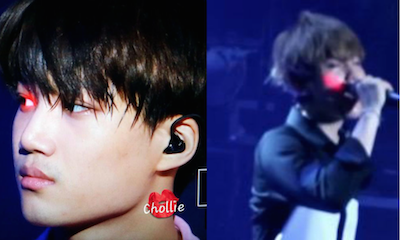
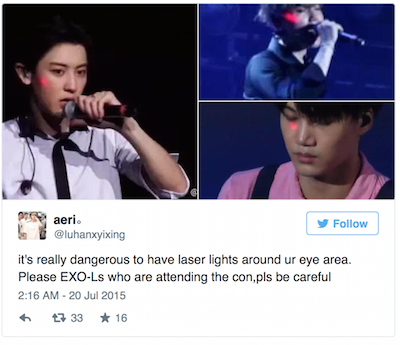
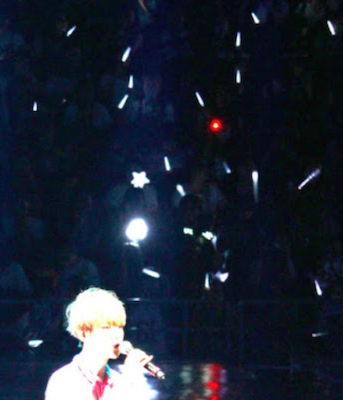
This photo shows a red light coming from the audience area, aimed towards the stage.
From Koreaboo, Kpop Chart, and KpopStarz
China: South Korea regrets laser pointer aimed at Chinese Premier by SK athlete
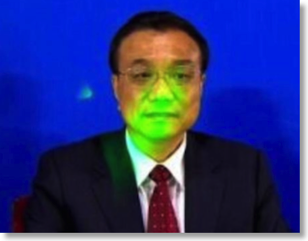
“Internet photo” from Want China Times showing Chinese Premier Li Keqiang, with green laser light on his face.
The South Korean embassy in Beijing issued a statement saying “It’s extremely improper and regrettable to shine a laser pointer on state leader. This should not have happened.”
According to the statement, the embassy was investigating in order to “confirm facts.”
China: Man detained 5 days for aiming laser pointer at football fans, players and referees
The man was caught by police, who said he would be held in custody five days.
From the Business Standard
US, China: Chinese warship used light to attack US spy ship
Condoleeza Rice, Secretary of State at the time, sent the cable to the U.S. Embassy in Beijing. Rice said that China’s actions were “provocative and inconsistent” with the law of the sea” and “constitute serious harassment and elevate the risk of miscalculation.”
Washington Times reporter Bill Gertz, who broke the story, was unable to find out whether the light was a laser or a high-powered searchlight. Gertz also pointed to parallels with the 1997 suspected laser use by the Russian merchant ship Kapitan Man.
From the Washington Times
Analysis: Based on the color, LaserPointerSafety.com believes it is a conventional light. To produce a white light beam with lasers requires superimposition of three or more single-color lasers. This is more difficult than using a single-color laser, and would not provide any significant benefit in a situation such as the ship attack. (If countermeasure anti-laser goggles are being used, then it may be beneficial to use multiple wavelengths. It is more difficult to defend against multiple wavelengths, and doing so would reduce conventional visibility since red, green and blue light would all be blocked. Even here, balancing the wavelengths to produce a “white” light is not necessary.)